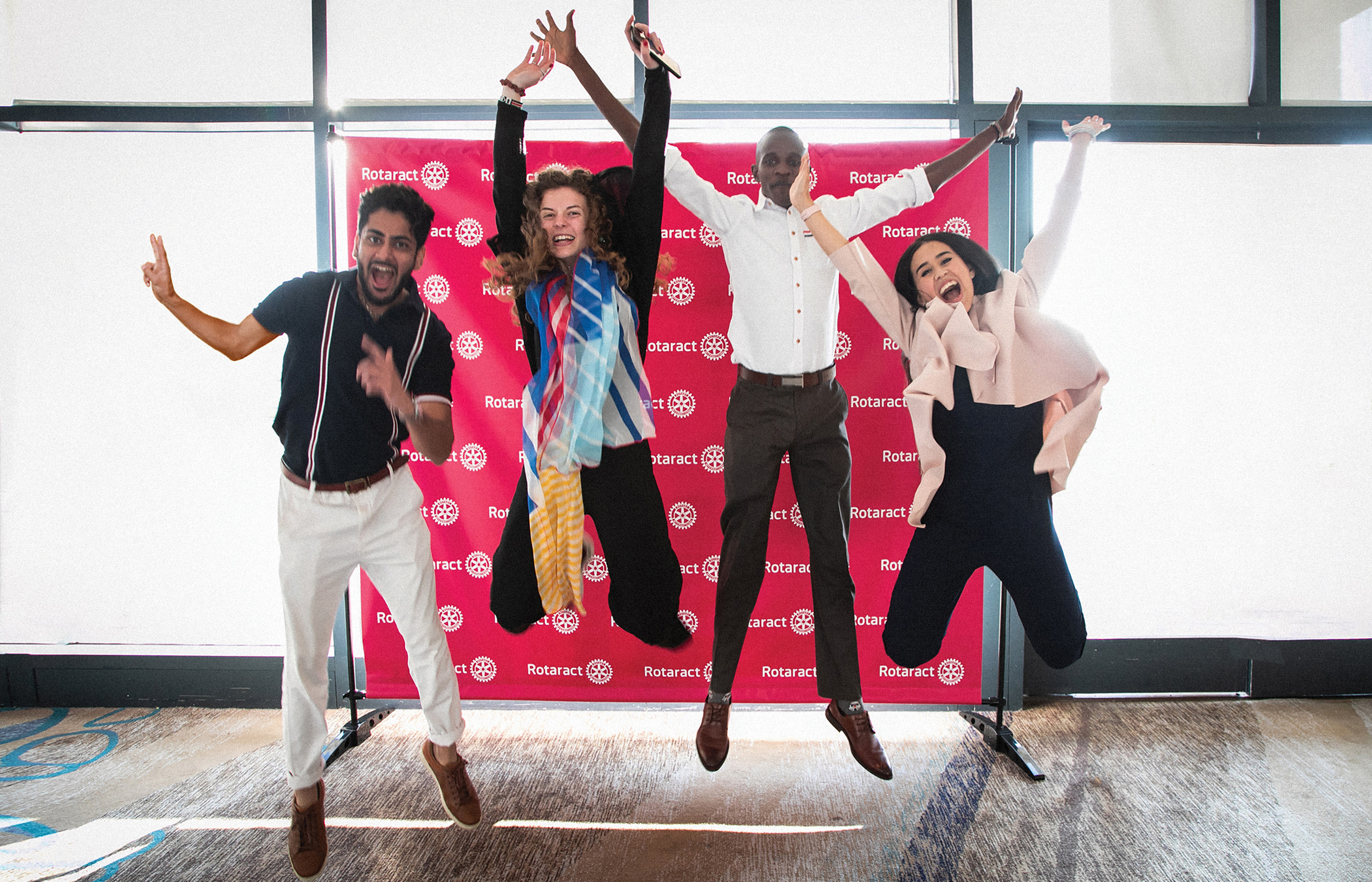The ongoing evolution of Rotaract is redefining its place within Rotary. “It’s a new era,” says one enthusiastic Rotaractor
Editor's Note: This story originally appeared in the May issue of The Rotarian magazine. Since publishing, Interota has been postponed to 2021. Learn more about next year's Interota.
At midnight on 30 June, hundreds of Rotaractors will ring in the new Rotary year together. They’ll also be celebrating Rotaract’s ongoing evolution, including the expansion of Rotary membership to include Rotaract clubs.
“It’s really exciting,” says Ignacio González, a member of the Rotaract Club of Oriente de Talca in Chile. Until recently, Rotaractors have been considered Rotary program participants. “Now,” says González, who serves on the Elevate Rotaract Task Force, “we are a part of Rotary. It’s a new era for Rotaract.”

Rotary programs include: Interact, Rotary Youth Exchange, Rotary Youth Leadership Awards, New Generations Service Exchange, Rotary Peace Fellowships, and Rotary Community Corps
Rotaract’s elevated status within the organization was approved by Rotary’s Council on Legislation in 2019 as part of an ongoing effort to make Rotary more appealing and welcoming to young professionals. “We keep telling Rotarians to find a way to bring in young people, when we have them already and we seem to forget them,” says 2018-19 Rotary President Barry Rassin. It was Rassin who formally proposed expanding the definition of Rotary membership to include both Rotary and Rotaract.
After the Council approved revising the RI Constitution and Bylaws to include Rotaract as a membership type, the Elevate Rotaract Task Force — made up of both Rotaractors and Rotarians — was formed and began surveying members to come up with policy recommendations for the transition. “We’re hearing from Rotaractors all over the world,” says David D. Stovall, RI treasurer and chair of the task force.
On the advice of the task force, the RI Board of Directors in October approved several changes to Rotaract — the most notable being the removal of Rotaract’s upper age limit. As of 1 July, members of Rotaract will no longer be required to leave their club when they turn 31. Clubs will still be able to set their own age limit, if they wish.

Rotaract clubs will be able to take advantage of products and services such as new leadership development resources from Toastmasters International, updated online goal-setting tools, and an improved online club administration experience.
Elyse Lin, a member of the Rotaract Club of Taipei Tin Harbour in Taiwan who is also on the task force, says the age limit was an obstacle for Rotaract members who wanted to stay involved with Rotary but either didn’t feel ready for a traditional Rotary club or found the expense of joining one out of reach. “Once those members leave, it’s very hard to get them back into the Rotary family,” Lin notes. Although some Rotaract alumni continue to participate in Rotaract events, she says, they often no longer feel like a true part of the organization. With the rules change, she predicts some recent alumni will rejoin Rotaract.
Other changes: New Rotaract clubs won’t have to rely on a Rotary club to sponsor them; they can now sponsor themselves or choose another Rotaract club as their sponsor. And Rotaractors are now eligible — and encouraged — to serve alongside Rotarians on district and RI committees. “Elevate Rotaract is really a call for a closer partnership between Rotary and Rotaract,” explains Clement Chinaza Owuamalam, a member of the Rotaract Club of Apo, Nigeria, who serves on the task force.
Rotaract clubs will also gain more support from Rotary International, including access to administrative tools on My Rotary and the option to subscribe to the digital edition of The Rotarian magazine. As the transition from Rotary program to membership type gets underway, the Trustees of The Rotary Foundation also plan to discuss whether Rotaract clubs should be eligible to apply for Foundation grants.

Rotary has a new alliance with Toastmasters International, and Rotary’s online learning center will host a curriculum created by Toastmasters that will help members improve their leadership and communication skills. To learn more, visit rotary.org/toastmasters.
One thing Rotaractors are looking for, says Ronald S. Kawaddwa, a member of the Rotary Club of Kasangati, Uganda, is more professional development opportunities. To meet this demand, a leadership training program Rotary is rolling out with Toastmasters will also be available to Rotaract members. “At age 30, you are launching your professional career,” says Kawaddwa, who is on the task force. “If Rotaract provides a better package in terms of professional development, that adds value.”
In 2022, annual dues of $5 per person for university-based Rotaract clubs and $8 for community-based clubs will be introduced to cover the cost of additional support for Rotaract clubs. RI will work to develop and promote alternative funding sources to help Rotaractors pay dues, including fundraising opportunities.
Kawaddwa says that shifting the public perception of Rotary is particularly important to attracting more young people in his region. “On the African continent, most of the population is below the age of 30,” he says. “If Rotary remained the way it was, it would soon become irrelevant.”
Letting Rotaract members stay in their clubs longer gives them more time to learn about Rotary, Kawaddwa adds. “We hope that these changes will produce stronger Rotarians, members who have served longer and gotten more experience and mentorship while in Rotaract.”

Frequently asked questions
What are the changes to Rotaract?
1
Rotaract is now a type of Rotary membership.
2
Rotaract clubs will be allowed to sponsor other Rotaract clubs or establish themselves without a sponsor.
3
Rotaract will be open to all young adults 18 and over. There will no longer be an upper age limit of 30.
The Trustees encourage Rotaract clubs to work with Rotary clubs on global grant projects.
4
Rotaractors are now eligible to serve on district-level and RI committees.
5
Rotaractors will enjoy greater support, training, and access to tools from Rotary.
6
In 2022, Rotaractors will pay annual per capita dues of either $5 or $8.
Rotary clubs should continue to work with Rotaractors at meetings and events and on service projects.
How were the changes to Rotaract decided on?
For several years, members of the RI Board, The Rotary Foundation Trustees, and Rotary committees, along with Rotarians and Rotaractors around the world, have been discussing how to recognize Rotaract clubs as Rotary clubs’ partners in service. Rotaractors offered their ideas to the Board through RI’s Rotaract Committee, at the annual Rotaract Preconvention, and through online surveys and focus groups.
Overwhelmingly, Rotaractors said they wanted more flexibility, more products and services, and more recognition from Rotary for the work they’re doing. After the 2019 Council on Legislation voted to recognize Rotaract clubs as a membership type, 2019-20 RI President Mark Daniel Maloney created the Elevate Rotaract Task Force to discuss how to update Rotaract policies and create an inclusive, innovative, and flexible membership experience.
Does this mean Rotaractors automatically become Rotarians?
No. Members of Rotary clubs are Rotarians and members of Rotaract clubs remain Rotaractors. This enactment will not change the separate identity of Rotaractors.
Do Rotaract clubs have to pay RI membership dues now?
The Board agreed that Rotaract clubs should begin paying per capita dues in 2022 and is looking at ways to offset the cost to members through fundraising and working with sponsor Rotary clubs. The annual cost will be $5 per person for university-based clubs and $8 for community-based clubs.
Will Rotaractors be able to use Rotary Foundation funds for their projects?
Right now, only Rotary clubs may apply for global and district grants from the Foundation. The Foundation Trustees determine who is eligible to apply for global grants and would review any proposal to allow Rotaract clubs access to Foundation funds. The Trustees encourage Rotaract clubs to work with Rotary clubs on global grant projects. Rotaract clubs can also receive funding from district grants through a Rotary club. As always, Rotaractors can apply for scholarships and Rotary Peace Fellowships through the Foundation.
Why was the upper age limit for Rotaract membership removed?
Rotaract clubs are still intended for younger professionals, but the Elevate Rotaract Task Force and the RI Board decided that it was important to give Rotaractors the flexibility to decide for themselves when they’re ready to leave Rotaract. The majority of Rotaractors surveyed believed that removing the age limit would either improve or not change their club experience and said they would still pursue joining a Rotary club in the future. Rotaract clubs will still be able to set their own age limit.
Will Rotaractors still be encouraged to become Rotarians?
Yes! Rotaractors will be encouraged to join clubs that offer the experience they want at any time. Rotary clubs should continue to work with Rotaractors at meetings and events and on service projects. Since 2016, Rotaractors have been able join a Rotary club while they are still active members of Rotaract clubs; that dual membership option will not change. Rotaractors can also start their own Rotary clubs.
Will Rotaractors be able to serve on or advise the RI Board or Trustees?
The Board and the Trustees value the input of Rotaractors and have recommended that the RI president appoint Rotaractors to committees. They will continue to discuss new ways to involve Rotaractors in the future.
Will Rotaract clubs be counted in Rotary’s overall membership numbers?
No. Rotaract clubs will not be counted in the total number of clubs in a district, and Rotarians and Rotaractors will continue to be counted separately.
Where can I find the revised policies about Rotaract?
Starting 1 July, the Rotary Code of Policies, in chapter II, “Clubs,” will have an updated article 12 titled “Rotaract Clubs.” The policies related to Rotaract that were in chapter V, “Programs,” under article 41.040 will be removed as of 1 July.
More questions? Write to rotaract@rotary.org.
We talked to members of the Elevate Rotaract Task Force. Here’s what six of them had to say about the changes.

Ignacio González
Age: 29
Occupation: Law student
Club: Rotaract Club of Oriente de Talca, Chile
Fun fact: I’ve lived in four countries, seven cities, and more than 20 houses.

Clement Chinaza Owuamalam
Age: 25
Occupation: Assistant programs officer, Sir Emeka Offor Foundation
Club: Rotaract Club of Apo, Nigeria
Fun fact: I have represented Rotaract on three continents.

Elyse (Yi-Chun) Lin
Age: 29
Occupation: Project manager, Manta Sleep
Club: Rotaract Club of Taipei Tin Harbour and Rotary Club of Taipei Daylight, Taiwan
Fun fact: I wrote our Rotaract club song when we chartered.

Ronald S. Kawaddwa
Age: 39
Occupation: CEO, Majestic Brands Limited
Club: Rotary Club of Kasangati, Uganda
Fun fact: I enjoy cracking jokes.

Melchor “Chock” P. Encabo
Age: 41
Occupation: Vice principal and social studies teacher
Club: Rotary Club of Metro Escolta, Philippines
Fun fact: Aside from teaching, I am busy creating content on my YouTube channel, ChockTalks.

Eduardo Souto
Age: 31
Occupation: School director
Club: Rotary Club of Conselheiro Lafaiete, Brazil
How will making Rotaract a membership type benefit Rotary?
Melchor Encabo: This will surely make the Rotary family bigger and stronger. Now that Rotaract is a new membership type, we can attract more young leaders who want to serve but are not yet ready to be a Rotary club member. This will open new opportunities for them to serve and to be part of this great organization.
Ignacio González: Rotaractors can feel that their actions are an important and unique part of the organization.
Ronald Kawaddwa: The Rotary brand will be more visible. The PR benefits from this will be a great value to our organization.
Elyse Lin: With more data on Rotaractors, we will be more able to develop strategies and tools to help grow the membership of Rotary by helping more young leaders to join Rotaract and more Rotaractors to transition to Rotary.
How will it benefit Rotaract members?
Encabo: A lot of former Rotaractors were forced to exit their clubs when they turned 31. With this new enactment, they get to stay with the organization that they love and serve as mentors to younger members.
González: Rotaractors will get a stronger sense of belonging with Rotary.
Eduardo Souto: Training, lectures, and participation of Rotaractors in Rotary events are some of the ways that Rotaractors will benefit from RI membership.
Lin: Rotaractors don’t have a club operations tool provided by RI like Rotary Club Central to help us manage club membership and service projects. Elevating Rotaract opens resources and opportunities like these to us.
What should Rotarians do differently now that Rotaractors are members too?
Lin: I would like to see more partnership between Rotarians and Rotaractors across all levels: club, district, zone, international. More Rotaractors should serve with Rotarians on RI committees and district committees, so that we have wider perspectives on topics and more partnership on social media for public image, service projects, and other Rotary events.
Clement Chinaza Owuamalam: Rotarians should not see Rotaract as being in competition with them. They should see it as an organization that will complement them.
Have you heard any concerns about the changes?
Encabo: Many Rotaractors are worried about paying for their membership. I tell them that this will only mean that Rotary International will be able to give us more services and training to better serve others.
Kawaddwa: I have heard concerns from Rotary clubs about the changes, especially those that think no younger members will be joining their clubs. I encourage them to focus on the benefits — we are solving the problem that we have had in the previous years when Rotaractors had to leave Rotary when they turned 31.
Lin: Rotaractors are worried that their club leadership team will become older when the age limit is removed. However, they can still restrict their membership or leadership composition in their club bylaws. I encourage Rotarians and Rotaractors to focus on the flexibility and opportunities these changes bring to us.
How should Rotaractors embrace this change?
Souto: Rotaractors should see these changes as a positive and bold step that shows how Rotary values young members. And that appreciation will turn into bigger partnerships, more members, more projects, better involvement with Rotary clubs, and greater participation in district decisions, allowing the growth of the entire organization.
Kawaddwa: I would love to see more proactive Rotaractors who have clearly defined goals to achieve as part of Rotary. Change is a fact of life, and Rotary is investing a lot of resources among our youth programs to create lasting change in people’s lives. I would like to see Rotaractors embrace these changes as another way to develop into extraordinary members of society.
Owuamalam: Before, learning about Rotary may not have been important for us. Now that we are a part of Rotary, we should learn more about Rotary’s structure and what’s available to us.
González: I want to see Rotaractors training more in how Rotary International works. When we understand where we are and how the entire organization works, nothing can stop us!
• This story originally appeared in the May 2020 issue of The Rotarian magazine.

